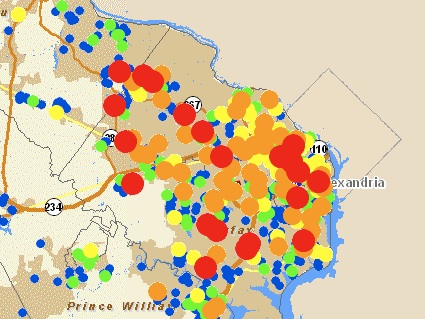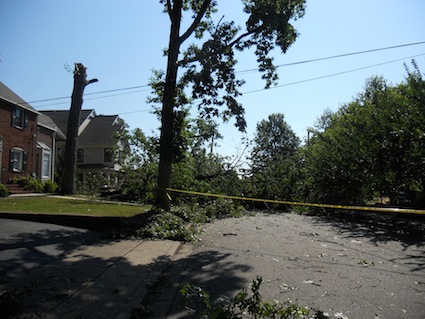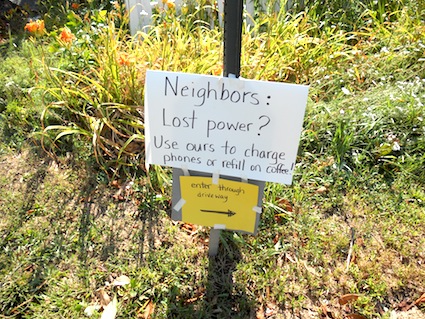Those 12MC readers expecting to see the results of Mexican foreshadowing will have to wait a little longer. It’s been a rather wild ride in the Washington, DC area over the last couple of days. The thermometer hit 104° Fahrenheit (40° c.) on Friday afternoon. That not only shattered a temperature extreme for the date, it was also the hottest day recorded in the month of June ever since record-keeping began something like 150 years ago. I had no intention of mentioning it on the Twelve Mile Circle, actually. It was a hot day. So what. It’s not like we’re in Arizona.
Derecho
It’s what came later that impressed me: an epic derecho like I’ve never seen before, feeding on searing heat and an intensely unstable air mass. As the U.S. National Weather Service’s Storm Prediction Center describes the phenomenon:
“A derecho (pronounced similar to ‘deh-REY-cho’ in English…) is a widespread, long-lived wind storm that is associated with a band of rapidly moving showers or thunderstorms. Although a derecho can produce destruction similar to that of tornadoes, the damage typically is directed in one direction along a relatively straight swath. As a result, the term ‘straight-line wind damage’ sometimes is used to describe derecho damage. By definition, if the wind damage swath extends more than 240 miles (about 400 kilometers) and includes wind gusts of at least 58 mph (93 km/h) or greater along most of its length, then the event may be classified as a derecho.”
This one pushed 700 miles and and hit with winds of 70-75 mph, leaving more than a million people in the Washington, DC area without electrical power when it finally arrived. It was memorable enough for Wikipedia to include a page within a few hours: June 2012 North American derecho.
The Storm Arrives
The derecho slammed into my home right around 10:45 pm and it left almost as quickly as it came. I knew it was bad, though. The light of a thousand lightning flashes silhouetted trees flailing violently, with branches and limbs ripped and thrown to the ground. A desperate message hit the neighborhood email list, “Can someone try to call 911 Power pole on northeast corner of [street x] and [street y] is *on fire* and 911 will not answer for me!” It was that kind of night.

Only daylight would reveal the true extent of damage that the Governor of Virginia called, “the broadest non-hurricane related power outage in Virginia history.”
Electrical power returned to our home sometime during the night — we were lucky, lines were down all over the region with widespread outages on three sides of our immediate community — but we did lose our fiber optic Internet access and television for most of the day (I’ll take air conditioning over Internet access during a heat wave, thank you very much, so no complaints there). We still don’t have telephone service, not that it really matters. I can’t remember the last time we received a legitimate telephone phone call on a land line. Maybe this will finally serve as motivation to get rid of it.
Touring the Damage
With brush cleared from the yard and no Internet to entertain us, my younger son and I went about our normal disaster ritual, a leisurely bike ride to survey the damage. We discovered immediately that our street escaped the worst of it. A microburst or some similarly destructive force slammed into a swath of streets about four blocks due east.

Notice the remainder of a tree on the left side of this photograph. That was a majestic oak at this time the day before. Now it’s a thirty-foot stump with its canopy completely blocking the road. I chatted with one of the nearby residents who’d parked two automobiles there the night before that somehow escaped unscathed. I think he should go play the Lotto. Stories repeated themselves up-and-down nearby streets: lots of tree damage; lots of electrical wires down; superficial damage to homes; and a feeling of gratefulness that it wasn’t worse.

I live in an older neighborhood of pre-war (WW2) homes and small lots. It embodies an aesthetic re-envisioned a half century later by the New Urbanism movement. It’s a walkable place anchored by the local elementary school. It feels more like the small town where I lived when I was younger, where everybody-knows-everybody. It’s remarkable to replicate this feeling at a place that’s within visible distance of the Washington Monument.
It doesn’t surprise me that all of the neighbors look out for each other when it’s time to dig out from the mess.
Epilogue
Just as I was getting ready to publish this on Saturday evening, reading over the draft a final time, the power went out for four hours. We still have a way to go, apparently.

Leave a Reply